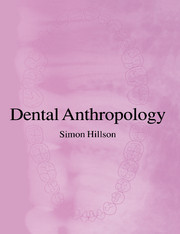Book contents
- Frontmatter
- Contents
- Acknowledgements
- Abbreviations
- 1 Introduction to dental anthropology
- 2 Dental anatomy
- 3 Variation in size and shape of teeth
- 4 Occlusion
- 5 Sequence and timing of dental growth
- 6 Dental enamel
- 7 Dentine
- 8 Dental cement
- 9 Histological methods of age determination
- 10 Biochemistry of dental tissues
- 11 Tooth wear and modification
- 12 Dental disease
- 13 Conclusion: current state, challenges and future developments in dental anthropology
- Appendix A: Field and laboratory methods
- Appendix B: Microscopy
- References
- Index
2 - Dental anatomy
Published online by Cambridge University Press: 05 June 2012
- Frontmatter
- Contents
- Acknowledgements
- Abbreviations
- 1 Introduction to dental anthropology
- 2 Dental anatomy
- 3 Variation in size and shape of teeth
- 4 Occlusion
- 5 Sequence and timing of dental growth
- 6 Dental enamel
- 7 Dentine
- 8 Dental cement
- 9 Histological methods of age determination
- 10 Biochemistry of dental tissues
- 11 Tooth wear and modification
- 12 Dental disease
- 13 Conclusion: current state, challenges and future developments in dental anthropology
- Appendix A: Field and laboratory methods
- Appendix B: Microscopy
- References
- Index
Summary
Terms and definitions
Further details for modern Homo sapiens are given in Jordan et al. (1992), Carlsen (1987), van Beek (1983) and Woelfl (1990), whereas details for other hominids are available in a variety of sources (Robinson, 1956; White et al., 1981; Wood & Abbott, 1983; Wood et al, 1983; Grine, 1985; Wood & Uytterschaut, 1987; Wood et al., 1988; Wood & Engelman, 1988; Wood, 1991; White et al., 1994), and the patterns of wear described in this chapter are based on the work of Murphy (1959a). Carlsen provided an alternative terminology of ‘fundamental macroscopic units’ for describing tooth morphology, which is not included here because it has not yet been employed in dental anthropology. For comparisons with non-human mammal teeth see publications by Hillson (1986a; 1992c) – the main potential confusions are with bear and pig molars, with incisors in deer, cattle and their relatives, and the great apes, which are described in detail, along with other primates, by Swindler (1976).
Labels for teeth
Each child has two dentitions. The deciduous (or milk) dentition is about half-formed by birth and erupts into the mouth during the next two years (page 124). It is replaced gradually by the permanent dentition, for which the first tooth starts to form just before birth, and the last tooth is finally completed in the early twenties. Each dentition is divided into four quadrants: upper left, upper right, lower left and lower right.
- Type
- Chapter
- Information
- Dental Anthropology , pp. 6 - 67Publisher: Cambridge University PressPrint publication year: 1996
- 1
- Cited by

